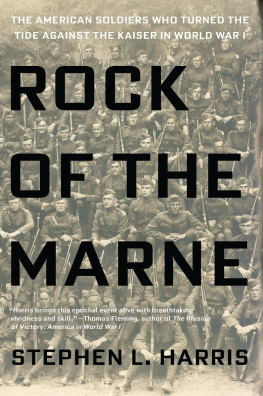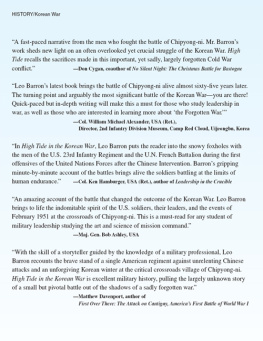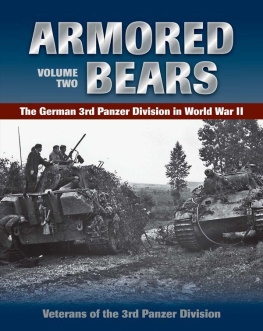A LSO BY S TEPHEN L. H ARRIS
100 Golden Olympians
Duty, Honor, Privilege: New Yorks Silk Stocking Regiment and the Breaking of the Hindenburg Line
Harlems Hell Fighters: The African-American 369th Infantry in World War I
Duffys War: Fr. Francis Duffy, Wild Bill Donovan and the Irish Fighting 69th in World War I

An imprint of Penguin Random House LLC
375 Hudson Street, New York, New York 10014
This book is an original publication of Penguin Random House LLC.
Copyright 2015 by Stephen L. Harris.
Penguin supports copyright. Copyright fuels creativity, encourages diverse voices, promotes free speech, and creates a vibrant culture. Thank you for buying an authorized edition of this book and for complying with copyright laws by not reproducing, scanning, or distributing any part of it in any form without permission. You are supporting writers and allowing Penguin to continue to publish books for every reader.
BERKLEY CALIBER and its logo are trademarks of Penguin Random House LLC.
For more information about the Penguin Group, visit penguin.com.
eBook ISBN: 978-0-698-16494-9
Library of Congress Cataloging-in-Publication Data
Harris, Stephen L.
Rock of the Marne : the American soldiers who turned the tide against the Kaiser in World War I / Stephen L. Harris. First edition.
p. cm.
Includes bibliographical references and index.
ISBN 978-0-425-27556-6 (alk. paper)
1. Marne, 2nd Battle of the, France, 1918. 2. United States. Army. Infantry Division, 3rdHistoryWorld War, 19141918. 3. World War, 19141918Regimental historiesUnited States. I. Title.
D545.M35H37 2015
940.4'34dc23
2015012222
First edition: October 2015
Map courtesy of the National Archives and Records Administration, Modern Military Records Branch.
While the author has made every effort to provide accurate telephone numbers and Internet addresses at the time of publication, neither the author nor the publisher is responsible for errors, or for changes that occur after publication. Further, the publisher does not have any control over and does not assume any responsibility for author or third-party websites or their content.

Version_2
To Sue once again, my soul mate since high school.
INTRODUCTION
The First World War (19141918) was the war that changed the world.
Empires were lost, monarchies overthrown, borders altered and new countries and new governments came into being. Horrific weapons of mass destruction were used for the first timeheavy artillery that fired from miles away, flattening towns and villages and even reaching into the heart of Paris; airplanes that dropped bombs from the sky; and poisonous gases that soaked the battlefield. Ten million people lost their lives. Millions more were hurt, either physically or mentally, soldiers and civilians alike. It was so ghastly it became known as the war to end all wars. And by the time it was over the United States had become a world power.
The cause of the war is still debated, but the assassination on June 28, 1914, of the heir to the Austria-Hungarian Empire, Archduke Franz Ferdinand, by Serb terrorists in Sarajevo, led to its start. His murder upset the balance of power between two groupsthe Triple Alliance of Germany, Austria-Hungary and Italy, later known as the Central Powers, and the Triple Entente of France, Russia and Great Britain, later the Allies. Relying on German support, Austria declared war on Serbia. In response, Russia mobilized against Austria, causing Germany to declare war on Russia and two days later to declare war on France. Then, attacking on two fronts, the Germans checked the Russians on the Eastern Front and, in an effort to reach Paris, swung through neutral Belgium on the Western Front. Because the Germans had invaded Belgium, Great Britain declared war on Germany. This declaration drew Canada, Australia, New Zealand and India into the conflict. Italy tried to remain neutral but eventually sided with the Allies. Meanwhile, the crumbling Ottoman Empire joined forces with Germany and Austria-Hungary. Other nations also joined the fight, opening multiple frontsincluding the Balkans, Egypt, Palestine and Arabia and even Persia. The United States, however, stayed out of the war.
On the Western Front, after the First Battle of the Marne, where the French stopped the Germans from reaching Paris, the war bogged down into trench warfare. Victories were measured in yards captured. The number of casualties was gruesome. The battles became legend: Belleau Wood, Chteau-Thierry, Caporetto, Gallipoli, Verdun, Vimy Ridge, the Somme, Passchendaele, Soissons, the Meuse-Argonne, the storming of the Hindenburg Line and, the turning point of the war and the subject of this book, the Second Battle of the Marne.
At sea, Great Britain strung a naval blockade around German ports. Germany responded with unrestricted submarine warfare. Its U-boats torpedoed merchant ships and then on May 7, 1915, without warning, sank the British luxury liner Lusitania. Among the 1,198 passengers and crew lost were 128 Americans. Reaction in the United States became so hostile against Germany that unlimited submarine warfare stopped.
The year 1917 finally brought the United States into the war. Germany not only resumed unrestricted submarine attacks, sinking more American ships, but also in secret negotiations tried to provoke Mexico into invading the United States if Mexicos neighbors to the north entered the war against the Central Powers. For the United States it was the last straw. On April 6, it went to war against Germany.
At the time, America was totally unprepared. It had a regular army of 127,588 soldiers and 76,713 National Guardsmen. When General John J. Pershing was put in command of the American Expeditionary Forces, he called for an army of over one million men. Building up that army, training it and then getting it to France in time to play a major role in the war was an extraordinary feat. It took almost a year before the United States had sufficient troops on the ground in Europe and elsewhere to make a difference in the outcome of the war.
In the spring of 1918 it made its presence known to the Germans at Cantigny, Soissons and Belleau Wood, and then, on July 15, Americans, fighting alongside the French, hurled back German armies attacking across the Marne River and in the Champagne region. With the Germans stopped, Ferdinand Foch, the supreme Allied commander, ordered a masterful counteroffensive that eventually drove the enemy back to the Hindenburg Line. There the Allies succeeded in storming the line.
On the eleventh hour of the eleventh day of the eleventh month, Germany capitulated and an armistice was signed. World War I was over.
WORLD WAR I TIMELINE
1914
June 28. Heir to the Austria-Hungarian Empire, Archduke Franz Ferdinand, assassinated in Sarajevo.
July 28. Austria-Hungarian Empire declares war on Serbia.
July 31. Russia, an ally of Serbia, mobilizes its military.



















